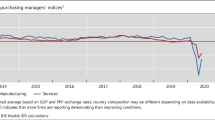Abstract
The following analysis of the 1992/93 crisis of the European Monetary System finds that the unfolding of the single market dynamics will make European Monetary Union a difficult stage to achieve. Further monetary integration is only feasible if full employment and sustained growth are achieved in the EC. The Maastricht Treaty needs some add-ons if economic and monetary union is to succeed.
Similar content being viewed by others
References
On this view see EC Commission: One Market, one Money, No. 44, Luxembourg 1990. For a broader analysis of the issues of the Maastricht Treaty and EC monetary union see P. J. J. Welfens (ed.): European Monetary Integration, 2nd enlarged edition, Berlin and New York 1993.
IMF: World Economic Outlook, Washington DC 1993.
Deutsche Bundesbank: Monatsberichte, November 1993.
Cf. M. Goldstein, D. J. Mathieson and T. Lane: Determinants and Systemic Consequences of International Capital Flows, in: IMF (ed.): Determinants and Systemic Consequences of International Capital Flows, p. 5.
On the increasing role of portfolio capital flows as a source of equity capital cf. Bank for International Settlements: Annual Report, Basle 1992; on related issues of foreign direct investment flows in Europe cf. M. Klein, P. J. J. Welfens (eds.): Multinationals in the New Europe and Global Trade, Berlin and New York 1992; and G. N. Yannopoulos: Multinational Corporations and the Single European Market, University of Reading Discussion Paper No. 45, Reading 1992.
F. Giavazzi, M. Pagano: The Advantage of Tying One's Hands: EMS Discipline and Central Bank Credibility, in: European Economic Review, Vol. 32, 1988, pp. 1055–1082; cf. also R. Barro, D. Gordon: Rules, Discretion and Reputation in a Model of Monetary Policy, in: Journal of Monetary Economics, July 1983, pp. 101–121.
Cf. F. Kydland, E. Prescott: Rules Rather than Discretion: The Inconsistency of Optimal Plans, in: Journal of Political Economy, 1977.
Cf. on this T. Lane: Market Discipline, IMF Working Paper, WP/92/42, Washington DC 1993, forthcoming in IMF Staff Papers.
Cf. IMF: German Unification, Economic Issues, Occasional Paper No. 75, Washington DC 1990; P. J. J. Welfens (ed.): Economic Aspects of German Unification, Heidelberg and New York, 2nd edition, 1994.
Cf. P. J. J. Welfens: Market-oriented Systemic Transformations in Eastern Europe, Berlin, New York 1992; P. J. J. Welfens (ed.): The Single Market and the Eastern Enlargement of the EC, Berlin, New York 1994.
Author information
Authors and Affiliations
Rights and permissions
About this article
Cite this article
Welfens, P.J.J. The single market and EMS instability. Intereconomics 29, 59–67 (1994). https://doi.org/10.1007/BF02928144
Issue Date:
DOI: https://doi.org/10.1007/BF02928144




